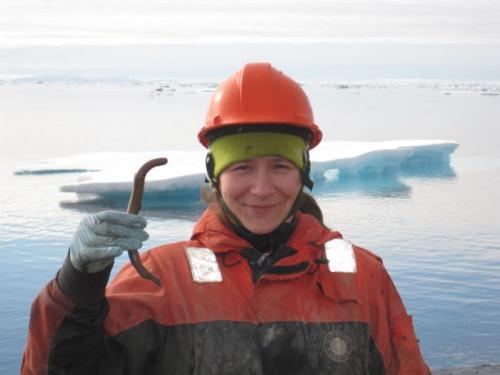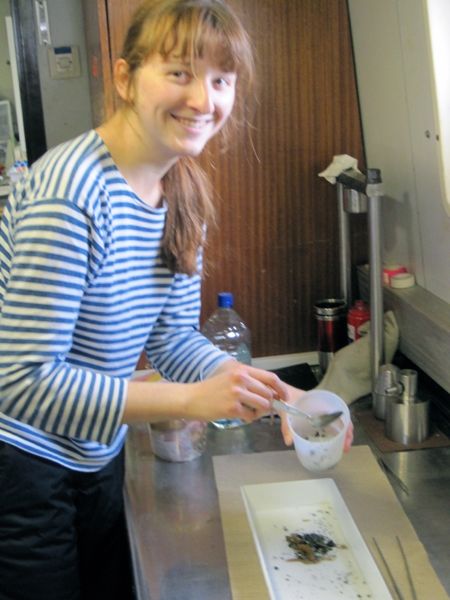We'll reach the last station that Jackie will do early tomorrow morning, and then we'll really start packing. Today we inventoried and sealed up the buckets with all of the samples from the van Veen grabs. That's a small start compared to all we'll have to do once the boxes come out of the hold and everyone gets to work packing, sorting, and cleaning up. Today's journal covers those on board who are not only working with a team but who are also collecting samples and data for their own individual projects the adding to their already packed workloads.

Monika Kedra works with me on Jackie's team, and she gets very excited each time we find a sipunculid worm in one of our grabs. Monika takes all of the organisms from our first grab and checks the sample for specimens. The large ones (check the picture to see how excited she is about the one we found recently) are easy to spot, but they can also be as small as 3 mm. Monica is interested in diversity and population studies in relation to environmental factors. She told me that she enjoys studying sipunculids because they are a little known group that plays a significant role in the environment by burrowing in the sediments. In addition, they provide food for fish, walrus and some gastropods. Monika also told me that there about 20 sipunculid specialists in the world and we have two of them on board the ship! I'll tell you about the other one when I post a journal about the Russian benthic team.
Arve Lynghammer is working with Kitty Mecklenburg and he's hoping to find skates in the fish they bring up. The Chukchi Sea is bordered on the east by the East Siberian Sea and on the west by the Beaufort SeaThe Beaufort Sea lies to the north of Alaska and the Yukon and Northwest Territories.. The Arctic skate has been found in both but never in the Chukchi. We've found none so far, but the cruise isn't over yet.

Jeff Pietro, an engineering assistant from Woods Hole Oceanographic Institute (WHOI) has been enormously helpful with the work of the CTDA research tool that is submerged in the water to measure conductivity (salinity), temperature, and depth. team, but his primary purpose on board is to deploy a mooring in 1000 meter deep water where it will become frozen in and then drift with the ice. He's accustomed to putting this type of mooring directly in the ice through a 10" drilled hole, but that not possible on this cruise. Once in place, the mooring has an inductive modem (Jeff calls it a "robot") that travels up and down the protected wire twice a day, sending real time data back to WHOI for up to 3 years. Although this type of mooring is called an expendable, they are sometimes retrieved if the opportunity arises. Since it was designed approximately 9 years ago, this is the 63rd one that's been deployed in the Arctic. Unfortunately, due to ice conditions, we weren't able to travel far enough north to get to the 1000 meter depth needed, and Jeff didn't put out the mooring.
Dasha (Daria) Petrova, a PhD student at St. Petersburg State University in the department of invertebrate zoology, is working with one of the fish teams on board, but she also takes the organisms from our last van Veen grab at each station. After sieving the mud, she picks through it carefully hoping to find small crustaceans called amphipods (they look like tiny, pink shrimp). She's trying to collect as many samples as possible to look for morphological differences in populations. She's also trying to identify their distribution in the Chukchi Sea and to look at their "preferences" based on the ecology of the areas sampled. Additionally, if would be great to find and identify a new species for this area. Although she hasn't collected a lot on this trip, she can access data from 1989, 1991, 2004, and 2005 that she can use for her work.
Elizaveta Ershova works with the zoology team but is also ***
Susan Mills, research assistant, WHOI, is a part of the CTDA research tool that is submerged in the water to measure conductivity (salinity), temperature, and depth. team, and she's working with the video plankton recorder (VPR) that's attached to the bottom of the CTDA research tool that is submerged in the water to measure conductivity (salinity), temperature, and depth. rosette. Susan is a research assistant for Carin Ashjain, who is currently on another research cruise. The VPR takes pictures of plankton (organisms that float in the water column) as the CTDA research tool that is submerged in the water to measure conductivity (salinity), temperature, and depth. rosette moves through the water. The pictures are recorded and downloaded and later analyzed to identify and quantify the species seen. The nice thing about the VPR is that it allows the scientists to view the organisms in an undisturbed environment.
Elena Voronina is a senior researcher from the Zoological Institute at St. Petersburg, Russia. On this cruise, she's collecting museum specimens of the fishes we bring up in the beam and otter trawls. She'll preserve them and bring them back for Natalia Chernova, who was on the '04 and '09 RUSALCA cruises but is out on another ship now. They are particularly interested in the areas around Wrangell Island and farther north that haven't been sampled as much due to ice cover, but she told me that even some of the common fishes aren't well represented in the museum collections.


Comments